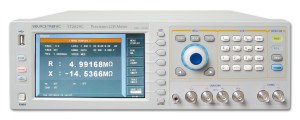LCR Meter
An LCR meter can be used to determine impedance, the complex resistance created by alternating currents. The LCR meter measures current, voltage and phase angle and calculates the corresponding LCR values, which can be represented in a number of forms (eg, Z, R a nd X, in a serial circuit diagram Ls and Rs or parallel circuit diagram Lp and Rp, etc.) There are hand held LCR meters which are generally easy to use, table mounted and laboratory versions – LCR meters are available in various sizes from 1 kHz to 100 MHz and above.
nd X, in a serial circuit diagram Ls and Rs or parallel circuit diagram Lp and Rp, etc.) There are hand held LCR meters which are generally easy to use, table mounted and laboratory versions – LCR meters are available in various sizes from 1 kHz to 100 MHz and above.
Besides the range determined, the frequency range also has to be calculated, with the frequency significantly affecting the price of the equipment. Generally you should measure the examples at the frequencies they will be operating at. In addition, LCR Meters often come with other useful features that include comparator and list sweep functions. In comparator mode you can enter the threshold values and tests samples that the meter will automatically grade as ‘PASS’ or ‘FAIL.’ The list sweep function enables testing of a DUT automatically with different frequencies, similar to an Impedance Analyser. An LCR meter is ideal for performing direct and precise measurements of inductors, capacitors and resistors using different test frequencies. The test area can be selected manually or automatically. The LCR meter can be operated fully automatically, eg in RS- 232, USB, LAN or Handler. Control software can be used to record the results.
« Back
